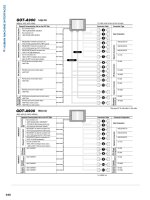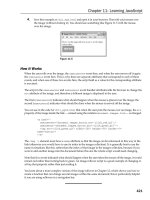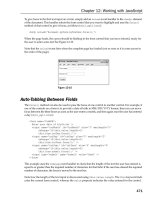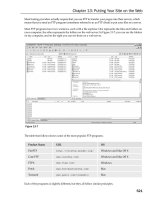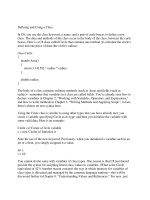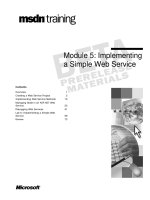Tài liệu Web Programming Using a Simple Server ( http://thisisplc.blogspot.com) pdf
Bạn đang xem bản rút gọn của tài liệu. Xem và tải ngay bản đầy đủ của tài liệu tại đây (168.93 KB, 19 trang )
Web Programming Using a Simple Server
Hypertext Markup Language (HTML) was developed by Tim Berners-Lee in 1992
1
along with his
invention of Hypertext Transfer Protocol (HTTP). Together HTML and HTTP created the World Wide
Web. Berners-Lee adapted Standard Generalized Markup Language
2
(SGML) tags for HTML, carrying
over some basic ones. HTML is used by browsers such as Internet Explorer and Firefox to format web
pages.
Many web sites are only used to convey information, however, some also request information from the
user and process that information. The most familiar example is that of e-commerce. Stores provide
forms that users fill out with their buying choices and credit card data. Forms are used in many other
contexts as well including logins and registrations.
The computer on the web site is called a server and the user’s computer is referred to as the client. There
are a number of commercial and open-source servers available including ones from Microsoft, SUN, and
the Apache Jakarta Project.
3
They all use basic networking protocols. A very simple version of a server
will be described below. It is helpful to students who wish to learn something about web programming
without having to get into the complications involved with a full server.
Network Programming using the Java Programming Language
The Java language has several classes that are used for network programming. They are in the java.net
package and are adaptations of the corresponding structures in C. The C structures were introduced in the
early 1980s by researchers in Berkeley while working with the UNIX operating system. The Socket class
is used for connecting client computers to a network, and the ServerSocket class is used by servers to
wait for incoming requests from clients.
The SocketImpl class is an abstract class that is the super class of all classes that implement sockets.
SocketImpl has four fields, the address of the host computer, the file descriptor, the localport on the client
computer, and the port on the host computer to which the client is connected. The host address may be
something like www.cnn.com, the Internet address of the Cable News Network. The port (an integer)
could be 80, the standard port for accessing web pages on web servers.
The Socket class is a subclass of SocketImpl and is used to create a client connection. The name comes
from a wall socket that is used to connect an electrical device, such as a lamp, to a source of electrical
power. The connection can be over a local area network (LAN), the Internet, or even using the local loop
within the computer itself. The local loop has the network address 127.0.0.1. It is often given the name,
localhost.
4
1
Dave Raggett , A History of HTML, Chapter 2, Addison Wesley Longman, 1998,
/>2
SGML was developed in the 1960s and 1970s. It was standardized by the ISL (International Standards
Organization) in 1986.
3
The Apache Project is located at />4
In Windows 2000 or XP, you can set localhost as an Environment Variable. Go into Settings/Control
Panel/System/Advanced/System Variables. Choose New and then enter localhost as the Variable name and
127.0.0.1 as the Variable value. In Windows 98, use Windows Explorer to find Autoexec.bat. It is in the C:\System
folder. Edit it and add the line SET localhost=127.0.0.1. When you next boot up your computer, this file will be
executed and will set the environment variable.
1
When a socket is created and opened by a Java program, it uses the Transmission Control Protocol
(TCP) /Internet Protocol (IP) or the User Datagram Protocol (UDP). TCP/IP is the principal network
protocol architecture used on the Internet. UDP is simpler and used when network reliability is not a
problem. TCP is a stream oriented protocol. That means that applications see input and output as streams
of data rather than discrete packets or frames. Therefore programmers can treat network input and output
in the same way as they do keyboard, screen and file I/O.
Hypertext Transfer Protocol
The World Wide Web primarily uses the Hypertext Transfer Protocol (HTTP). HTTP sits on top of
TCP/IP and adds functionality needed for web actions such as sending requests, receiving responses and
following hyperlinks from one web address to another. It is designed for rapid hops across the Internet
and so keeps a connection open for just one transaction.
HTTP is said to be stateless. That means that a web server has no memory of its clients. Internet
companies manage this either by depositing a cookie on the client’s computer or by issuing a session
identification number included in the URL string. For example, the following URL string was generated
by the barnesandnoble.com server:
/>The userid for this specific session is 0FJHK58GK6. It follows the user as he or she moves around the
web site. However, it is dropped when the user clicks on the Back button. Users that use the Back button
and do not accept cookies may lose the contents of their shopping carts.
Web browsers such as Internet Explorer and Firefox are configured for HTTP. When you use one of
these browsers, it will open a client socket and send a request to the URL (Uniform Resource Locator)
address given.
When the server sends back a web page, the browser formats it for display on your computer. The
formatting instructions are written in HTML. The World Wide Web Consortium (W3C) publishes
recommendations for browser and web page designers to follow. W3C has issued a number of updates
and is now working on Extensible Hypertext Markup Language (XHTML). XHTML “is a family of
current and future document types and modules that reproduce, subset, and extend HTML, reformulated
in XML.”
5
(XML stands for Extensible Markup Language.)
A Java Program with a Client Socket
Before looking at server code, we will consider a simple Java program that will connect to one of the
servers maintained by the National Institute of Standards and Technology (NIST). NIST has several
atomic clocks that are the most accurate ones in the US. (The world clock is in Paris, France.) These
clocks are kept synchronized and can be accessed by anyone using the Internet. NIST has several sites in
this country. The one used by the program below is in Gaithersburg, Maryland. Its URL is time.nist.gov.
NIST keeps this site open all the time; the port that services date and time requests is 13.
As mentioned, the Socket class is in java.net, which must be imported into the program. Also just about
anything that you do with networks can throw an exception, so one will have to be caught or re-thrown.
5
/>2
The creation of an instance of a socket throws an IOException and an UnknownHostException. The
latter is a subclass of the former; therefore it is only necessary to catch the first.
The first thing that NIST sends is a blank line. The second thing is the date and time using Greenwich
Mean Time (GMT). The following is a sample of the output from the program.
53472 05-04-12 14:10:53 50 0 0 402.4 UTC<NIST> *
When a new instance of a socket is created, it is associated with an I/O stream. We can use both
getInputStream () and getOutputStream () in order to use this stream. As usual, we need a
BufferedReader and a PrintWriter to use them efficiently.
import java.io.*;
import java.net.*;
public class NIST
{ public static void main (String [] args)
{ try
{
// Create an instance of a stream socket connected to NIST on port 13.
Socket socket = new Socket ("time.nist.gov", 13);
// Get a BufferedReader to read data from the socket’s InputStream.
BufferedReader reader = new BufferedReader (new InputStreamReader
socket.getInputStream ()));
// Read two lines from the BufferedReader and display them in the console window.
for (int count = 0; count < 2; count++)
{
String time = reader.readLine ();
System.out.println (time);
}
} catch (IOException e) {System.out.println ("Network error." + e);}
} // main
} // NIST
A Simple Web Server
The following server was developed by Cathy Zura
6
for her class at Pace University. I extended it so that
it would work somewhat the same as the Apache Tomcat server. It does only a fraction of the work that
Tomcat does, but it demonstrates some of the things that a server must do.
This server first gets a port from the user. This can be a default port, 8080 in this example, or it can be
some other number. In any case, the port chosen must be the same one that will be used by the client’s
browser. Next the server gets an instance of the ServerSocket class. This class is used for sockets on a
server that wait for a request from a client.
ServerSocket serverSocket = new ServerSocket (port);
6
Cathy Zura, Class Notes for CS 396N, 2003.
3
The server program now is ready to receive a request and act upon it. When it receives a request, it will
accept it with the following code:
Socket clientSocket = serverSocket.accept ();
This completes the connection between the server and this particular client.
The next thing it does is to create a new instance of the Server class. This class is a thread and can be
created and started with one command.
new Server (clientSocket).start ();
All this is done within an infinite loop (while (true)). This way, the server’s socket will stay open for as
long as it is needed to receive web page requests. To close the server program, you have to click on the X
in the upper right hand corner of the console window. The full code for the WebServer class follows:
/**
The Web Server opens a port and gets a new ServerSocket. When a web page client opens a socket on
the same port, it accepts the connection and creates a thread to handle it. It also keeps a count of the
number of threads created.
**/
import java.io.*;
import java.util.*;
import java.net.*; // The Socket classes are in the java.net package.
public class WebServer
{
public static void main (String [] args)
{
Scanner keyboard = new Scanner (System.in);
final int DefaultPort = 8080;
try
{
// Set the port that the server will listen on.
System.out.print ("Port: ");
String portStr = keyboard.nextLine ();
int port;
if (portStr.equals ("")) port = DefaultPort; // Use the default port.
else port = Integer.parseInt (portStr); // Use a different port.
int count = 1; // Track the number of clients.
ServerSocket serverSocket = new ServerSocket (port);
while (true)
{
Socket clientSocket = serverSocket.accept (); // Respond to the client.
System.out.println ("Client " + count + " starting:");
new Server (clientSocket).start ();
count ++;
}
} catch (IOException e) {System.out.println ("IO Exception");}
catch (NumberFormatException e) {System.out.println ("Number error");}
} //main
} // WebServer
4
The Client’s Web Page
The server is designed to connect with a client through a web page. The client downloads the web page
from the server and then fills out a form on the page. This might be an order form for buying a product or
a registration form that will sign a client up for some service. The following is a sample form that only
requests the client’s name and e-mail address.
<!DOCTYPE HTML PUBLIC "-//W3C//DTD HTML 4.0 Transitional//EN">
<html>
<head><title>E-Mail Form</title></head>
<body>
<h3>Enter your name and e-mail address.
<br />Then click the Send button to send the data to the server.</h3>
<form method = "get" action="http://localhost:8080/EmailProcessor">
<p><input type = "text" name = "name" value = "" size = 30 /> Name </p>
<p><input type = "text" name = "email" value = "" size = 30 /> E-Mail Address </p>
<p><input type="submit" value="Send" /></p>
</form>
</body>
</html>
Displayed by a browser, the form looks as follows:
The form uses the default port number, 8080. If the server is assigned a different port, the web page will
not be processed. Since the web page is normally downloaded from the server before it is filled out, the
programmer knows the port that will be used. (The standard port for web pages on the Internet is 80.)
The Server Class
The web page form is used to send a request to the server. When that request is received, the WebServer
class creates a thread to process the request. Here this is done by a class simply called Server. This class
performs several tasks.
The Server class first uses the clientSocket sent to it by the WebServer class to get a BufferedReader and
then reads the first line. This line is the URL string created by the browser.
7
The one generated from the
form above is
7
The browsers used in the examples are Internet Explorer 6 and Netscape 7.
5
GET /EmailProcessor?name=Alice+Lee&email=alee%40aol.com HTTP/1.1.
The browser creates part of the string from the method and action line in the form and the rest from the
input data. It uses the action statement of the form,
action="http://localhost:8080/EmailProcessor"
to find the address of the server, here the local host with port number 8080. It also uses the action
statement to find the name of the program on the server that is to process the request.
The URL string, then, starts with the method, here GET, followed by a space and a ‘/’. The processor
name is next. It is separated from the rest of the data by a question mark, ‘?’. After all the data from the
form, the browser adds a space and the version of HTTP used by the browser, here HTTP/1.1. The
request data is taken from the input boxes of the form. It can also come from other form objects such as
list boxes or radio buttons.
The first box contributes ‘name=Alice+Lee’ to the URL string, and ‘email=alee%40aol.com’ comes from
the second box. In general, the URL string is coded with all spaces replaced by the ‘+’ sign, and data
items separated by ampersands (&). Letters and digits are not changed, but a number of other characters
are replaced by the percent sign (%) followed by the ascii code for the character. For example, the ‘at’
sign (@) is replaced by %40 (in Netscape, but not Internet Explorer).
The Server class uses a StringTokenizer to separate the string into its parts. It is instantiated by
StringTokenizer tokenizer = new StringTokenizer (urlString, "/?&= ");
where urlString contains the data above. The delimiters for the tokenizer are ‘/’, ‘?’, ‘&’, ‘=’, and space.
They are all to be discarded. The ‘+’ sign is retained in order to determine the location of spaces in the
data. After the method and processor name are saved, the tokenizer is sent to a class called Request that
uses it to retrieve and store the remainder of the data. This class will be discussed later. The server also
gets an instance of the Response class. It will be used to get a PrintWriter for sending responses back to
the client.
When the Request and Response classes have been created, the server is ready to create an instance of the
class that is to process the data. In this example, it is called EmailProcessor. It has saved the name
previously, so all it has to do is instantiate it. This is done using the method, newInstance (), which is in
Class, a subclass of Object. First it is necessary to initialize the class, and this is done with
Class.forName (processName). forName is a static method that returns the Class object associated with
the class or interface with the given string name, here processName.
The server then has to start the processor. For this, it must know the name of the method in the
processing class that does the work. For Java servlets, there are several methods including doGet and
doPost. This example uses a single method called process. It has two parameters, the Request and
Response classes. Every program that is instantiated by the server has to have this method, so it is
included in an abstract class called WebRequestProcessor. All processor classes must extend this class.
Note that it is contained in a package called client_server.
package client_server;
// An abstract class that defines a set of processing classes.
public abstract class WebRequestProcessor
{
// An abstract method that processes a request.
public abstract void process (Request request, Response response);
} // WebRequestProcessor
6
Instead of a class, the above could just as easily be an interface. It would work the same way.
The lines of code in the server now are
WebRequestProcessor processor =
(WebRequestProcessor) Class.forName (processName).newInstance ();
processor.process (request, response);
As described above, processor is a new instance of a WebRequestProcessor class with the name,
processName, obtained from the URLString. The method that does the work is called process, and it has
instances of the Request and Response classes as parameters.
/**
The Server class is a thread. It reads the URL string from the client's socket. It then gets a
StringTokenizer for the string and uses the tokenizer to parse it. The first two tokens in the string are the
method (get or post) and the name of the class that is to process the request. The remainder of the tokens
is sent to the Request class for further processing. The process method in the processor class is then
started.
**/
class Server extends Thread
{
WebRequestProcessor processor;
Socket clientSocket;
public Server (Socket clientSocket) {this.clientSocket = clientSocket;}
public void run ()
{
String urlString, method, processName;
try
{
// Get an input stream for the client’s socket.
InputStream inStream = clientSocket.getInputStream ();
BufferedReader in = new BufferedReader (new InputStreamReader (inStream));
// Read the URL string and tokenize it.
urlString = in.readLine();
System.out.println (urlString);
StringTokenizer tokenizer = new StringTokenizer(urlString, "/?&= ");
// Get the first two tokens and send the rest of the tokens to the Request class.
method = tokenizer.nextToken();
System.out.println (method);
processName = tokenizer.nextToken();
System.out.println (processName);
// Set up the Request and Response clases.
Request request = new Request (tokenizer, method);
OutputStream outStream = clientSocket.getOutputStream ();
Response response = new Response (outStream);
7


